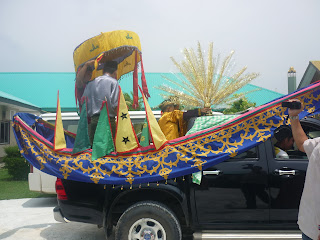bride
clothing and bridal bed
Maxim 'let die young, dying custom,' still debated until now century millenium. This is due to some custom which is still done by most societies 'One single Sabai Pepatih Nan Nan Aluih' or Negeri Sembilan, especially pepatih marriage customs. No wonder, if even today many men are 'somewhat reluctant to edit pure virgin Queensland, because customs and conditions are quite complicated. Here is the layout of custom wedding ceremony pepatih.
Merisik customs and Propose
Starting as early as the spy, the host (the bride) will make arrangements such as installing the palate which is mounted on top of the fabric roof surface. The groom will be represented by buapak of her tribe, as well as the bride, who was represented by buapak of her tribe. This spy custom made to ensure that proposed to the girl yet berpunya. In this ceremony, the groom should prepare questions ring as usual Malay wedding customs.
Epoch and bujam or betel for consumption must be accompanied by the man and handed to the woman. Having gained a consensus of both male and female sides, engagement date is also fixed.
In the engagement ceremony, the man must provide engagement and handed to the woman. Buapak two quarters, will set a wedding date. Ask rings that have been submitted during the customary spy returned to the man. This process is known as the ring expands. The ring must then be referred to buapak and other perennial beneficiaries.
Having determined the day, buapak behalf buapak men should speak to the woman, about some things, which include:
a. female dowry shall be spoken
b. charred expenses requested by the woman
c. money to pay wages marriage
d. money pirated door
e. money in khariah
f. custom money for buapak
So with these questions terjawabnya, settled tradition of engagement, and recited prayers.
Custom dwelt
Having both male and female sides agreed to unite their two children, buapak will ask about the wedding, which will be made. Buapak then be announced to the villagers to come and work during the upcoming feast, where every person shall have the responsibilities and duties of each. The ceremony was named dwelt. It is done to strengthen the brotherly relations between villagers and cooperate in any situation.
Upholding custom Bride
Among the interesting ceremony in custom wedding uphold pepatih is adapt. Brides will greeted and paraded up to the house. Stretcher will be refurbished and tied to bamboo.
Before the bride up into the house, the bride will wash away. The ceremony was performed by relatives. Purpose to do so is to show the Malays are rich in decency and hygiene before entering a house.
Custom splatter
The ceremony was started by buapak, followed by fathers, other board. Once done splatter distinguished guests, then followed by family members, relatives and other friends.
Feeding custom
Another interesting ritual is the custom of bribing feeds. In this ceremony, the bride will try to feed the yellow glutinous rice into the mouth of his mate, while the spouse must avoid. The ceremony was assisted by family members.
Mr dishes Board
Buapak and father of the Board will be treated in places provided by the host. By rule, the food served to them should be isolated and covered with fabric lined with food cover. This as a sign of gratitude to the Board, Mr. Buapak and for being willing to attend the wedding ceremony of their son.
Customary Worship
To complement adapt, last rites ritual worship. In this ceremony, the bride will shake his family members. Bride to be introduced to family members and relatives of a new, so do not feel awkward after becoming husband and wife. The ceremony began with the bride greets Buapak, followed by other perennial beneficiaries.
Matter of great concern to the Queensland community are not married to each quarter. Society with custom pepatih barred from marrying each quarter. Those who violate this prohibition shall be eliminated or removed from the area of. So much respect for customs, Queensland society adheres to this taboo until now. They believe that if abstinence is not held, then the family or tribe will be involved in the disaster.
Custom wedding pepatih unlike ordinary marriage. This wedding special is that attended and helped by the arrival Buapak, Father of the Board, General customs and village heads.










.jpg)





.jpg)
.jpg)
.jpg)


